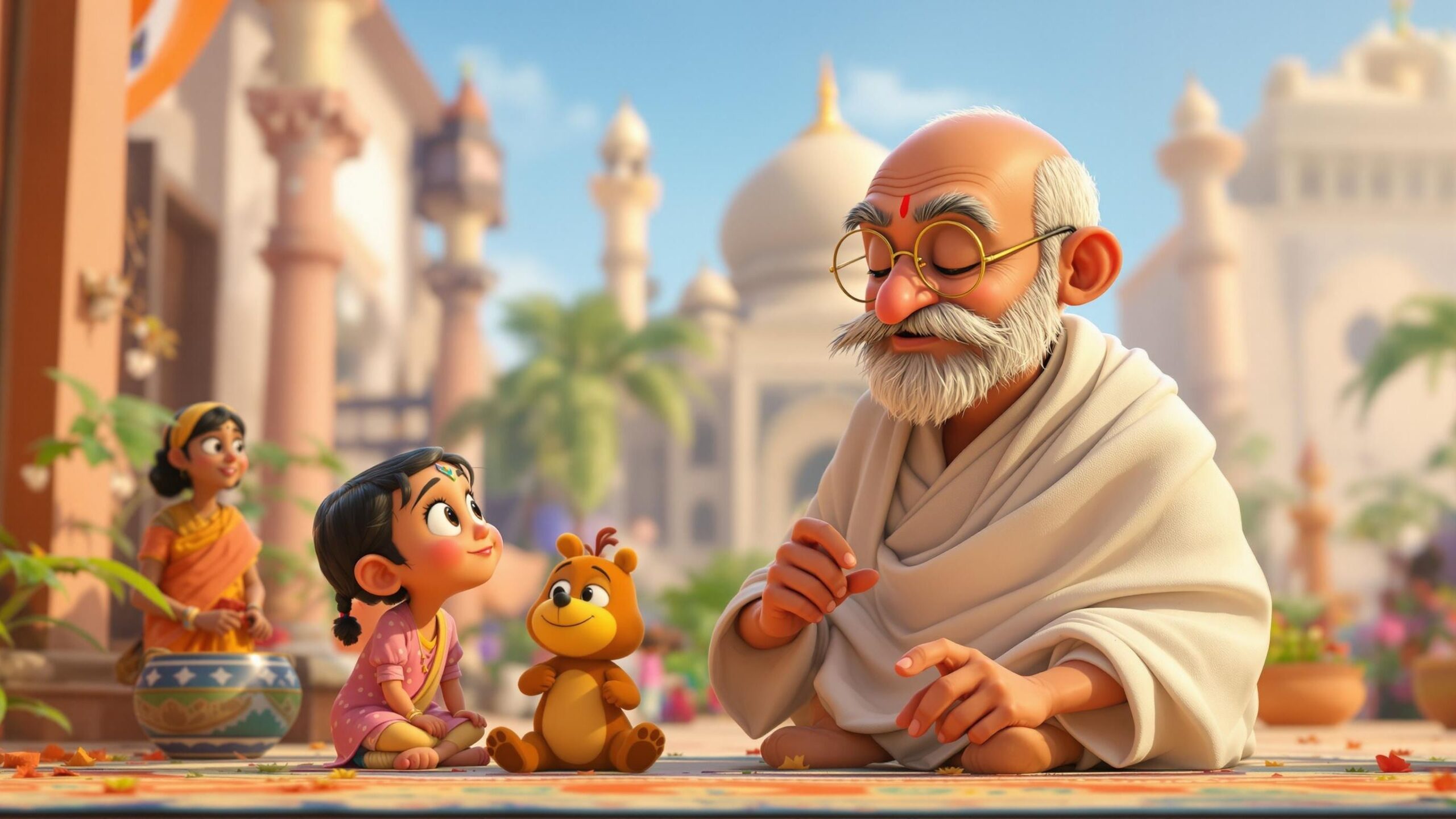The Humble Revolutionary Who Wore Simplicity Like Armor
He didn’t ride into battle on horseback. He didn’t carry a sword, nor did he command armies. He walked barefoot, wore homespun cotton, and carried a stick—not as a weapon, but as a symbol of strength rooted in humility. Mohandas Karamchand Gandhi, the man the world would come to call Mahatma, rewrote the rulebook of revolution. In an age when liberation was often soaked in blood, Gandhi dared to imagine—and execute—a new kind of fight: one without violence.
In a world enthralled by brute force, Gandhi proved that the sharpest weapon was moral conviction. With patience, courage, and an unwavering belief in justice, he stood up to the mighty British Empire and led a nation to freedom without ever firing a single shot. He became the face of resistance, the soul of a movement, and the heartbeat of a free India.
From London to South Africa: The Making of a Maverick
Born in 1869 in Porbandar, Gujarat, Gandhi’s early life gave no hints of the global legend he would become. He was a quiet child, shy and unremarkable. But that changed when he traveled to London to study law. There, amidst foggy streets and Victorian customs, Gandhi encountered the complexities of British society. But it wasn’t until he moved to South Africa that his journey truly began.
It was in South Africa that Gandhi experienced firsthand the cruelty of racial discrimination. One fateful train ride in Pietermaritzburg, where he was thrown out of first class for being Indian, lit the first fire of rebellion within him. But instead of choosing retaliation, he chose resistance—measured, methodical, and moral. He organized protests, formed the Natal Indian Congress, and tested the power of what he would later call satyagraha—truth-force.
These years were his crucible. Gandhi shed his Western attire, embraced simplicity, and began crafting the philosophy that would one day shake empires.
Satyagraha: The Weapon of the Spirit
When Gandhi returned to India in 1915, he brought with him a revolutionary idea—that injustice could be defeated without violence. He called it satyagraha, a blend of Sanskrit words meaning “truth” and “holding firmly.” This was no passive resistance; it was active, courageous, and deeply personal.
Satyagraha required the protester to suffer willingly, to refuse cooperation with evil without hatred for the evildoer. It demanded immense discipline and moral clarity. To outsiders, it looked like meekness. In reality, it was the most daring form of defiance.
Gandhi didn’t just preach it—he lived it. He welcomed prison, fasted for peace, and faced down batons with bare hands. His philosophy disarmed oppressors not with fire, but with conscience. It was an idea so bold, so pure, and so powerful that even those in power began to pause.
The Salt March: When a Grain Became a Tsunami
In 1930, the British controlled every aspect of Indian life—even salt. They taxed it heavily, making the most basic necessity a symbol of oppression. Gandhi saw in salt an opportunity to strike not with violence, but with symbolism. So he walked—241 miles, from his Sabarmati Ashram to the Arabian Sea.
With each step of the Salt March, more followers joined. Men, women, children—people of every caste and creed. By the time he reached the shore, he wasn’t alone. He bent down, scooped a handful of salt, and with that simple act, declared civil disobedience.
The Salt March became a national awakening. It showed that freedom didn’t require guns or bombs—just people willing to stand, walk, and defy. The world watched in awe. Newspapers from London to New York splashed Gandhi’s image across their front pages. India had found its voice, and Gandhi had found his rhythm.
Spinning Wheels and Swadeshi Dreams
For Gandhi, freedom wasn’t just political—it was economic, cultural, and deeply personal. He saw British rule not just in government offices but in the clothes people wore, the goods they bought, and the way they thought. So he spun a revolution—literally.
The spinning wheel, or charkha, became Gandhi’s tool of protest. He urged Indians to reject British-made textiles and embrace khadi, handspun Indian cloth. He spun daily himself, making it a spiritual practice and a national statement. It wasn’t just about clothes—it was about reclaiming dignity, jobs, and identity.
Soon, swadeshi—the movement to support Indian goods—became a cornerstone of the independence struggle. Markets shifted. Factories trembled. Gandhi showed that true power lay not in dependence, but in self-reliance. Every thread of khadi was a thread in the tapestry of freedom.
Jail Time and Moral Triumphs
Over the course of his struggle, Gandhi was arrested many times. He wore prison as a badge of honor, turning every sentence into a spotlight on injustice. Rather than silence him, jail amplified his voice. Letters, essays, and declarations poured from his cell. His message—rooted in love and truth—traveled far beyond any prison walls.
Each arrest sparked outrage and inspired more followers. Each fast he undertook became a national event. Gandhi made his suffering political theater of the highest order—not to win sympathy, but to prick the conscience of the nation and the world.
Even his enemies began to respect him. British officials found themselves in the uncomfortable position of jailing a man who neither cursed nor fought, but who nonetheless commanded the loyalty of millions. In trying to contain him, they only made his movement more magnetic.
Uniting the Fragmented: The Master of Moral Strategy
India was no monolith. It was—and still is—a mosaic of religions, languages, castes, and communities. Gandhi’s genius wasn’t just in fighting the British—it was in uniting India behind a shared cause.
He reached across lines that had long divided Indians. He spoke to Hindus, Muslims, Sikhs, Christians. He visited untouchable communities, insisting they be called Harijans—children of God. He walked into villages, washed the feet of the poor, and declared that freedom without social justice was meaningless.
He was not without critics—many accused him of being too idealistic, too slow, or too stubborn. But even they couldn’t deny that Gandhi had done the impossible: he made a fragmented subcontinent believe in itself. He turned the idea of India into a movement that beat with a single heart.
The World Watches a Saint in Action
Gandhi’s methods weren’t just revolutionary in India—they were revolutionary, period. While other nations armed themselves for independence, Gandhi’s India disarmed with dignity. He showed the world that power didn’t need to be brutal to be effective.
Global leaders took note. Martin Luther King Jr. would later say that Christ gave the message, but Gandhi showed how to live it. Nelson Mandela studied Gandhi’s strategies while imprisoned on Robben Island. Even in far corners of the world, oppressed people found hope in Gandhi’s blueprint.
He gave the powerless a method to reclaim power. He gave the voiceless a language the world couldn’t ignore. He made it cool to resist—and honorable to forgive.
Independence Achieved, But at a Cost
On August 15, 1947, India finally tasted the freedom it had long yearned for. The Union Jack was lowered. The tricolor was raised. And millions rejoiced. But Gandhi, the man who had led the charge, spent that day not in celebration, but in prayer and fasting. Why? Because partition had torn India and Pakistan apart, and with it came a tidal wave of violence.
Gandhi walked through riot-ravaged streets, pleading for peace. He visited refugee camps, tried to calm furious mobs, and fasted to stop the bloodshed. He had fought for unity—and now watched his nation bleed through its wounds.
His heartbreak was palpable. But even in despair, he held firm to nonviolence, proving that principles aren’t just for peacetime—they are tested most when the world falls apart.
A Life Taken, A Legacy Eternal
On January 30, 1948, while walking to his evening prayer, Gandhi was assassinated by a Hindu extremist who believed Gandhi had betrayed the Hindu cause by being too conciliatory to Muslims. A bullet silenced the man, but not his message.
The world mourned. Leaders from every continent paid tribute. Albert Einstein said, “Generations to come will scarce believe that such a one as this ever in flesh and blood walked upon this earth.”
And yet, his presence remains—etched into the hearts of freedom fighters, etched into the pages of history, and etched into the soul of India.
Gandhi’s Greatest Victory: A New Kind of Hero
In the age of warriors and warlords, Gandhi proved that you didn’t need armies to change the world. You needed integrity. You didn’t need to draw blood—you needed to awaken minds. He turned protest into poetry, rebellion into reflection, and revolution into redemption.
His success wasn’t just in ousting the British—it was in redefining heroism. He gave humanity a new kind of role model: one who wore no medals, fought no battles, and yet conquered the unconquerable.
His legacy lives in every peaceful protest, every nonviolent movement, every march for justice from Selma to Soweto. He gave us a roadmap for resistance that still lights the way.
The Man Who Walked Lightly But Left Giant Footprints
Mahatma Gandhi didn’t lead with force—he led with force of will. He didn’t scream to be heard—he whispered truth until the world leaned in. He didn’t ask for power—he gave power to the people.
He taught us that the mightiest revolutions are those of the spirit. That nonviolence isn’t passivity—it’s courage in its purest form. That freedom isn’t granted—it’s earned by those brave enough to demand it without hate.
He wore simplicity like royalty, carried a walking stick like a scepter, and ruled the hearts of millions without a crown. Gandhi didn’t just change a nation. He changed the way we think about change itself.
And in doing so, he showed us that sometimes, the most powerful shot ever fired—is the one never taken.





